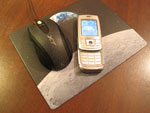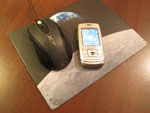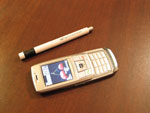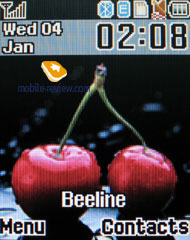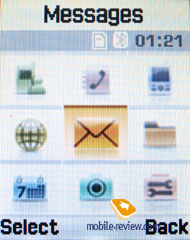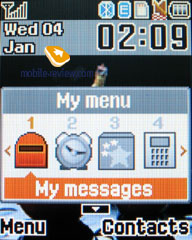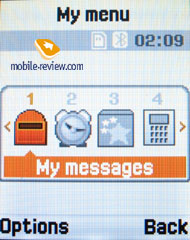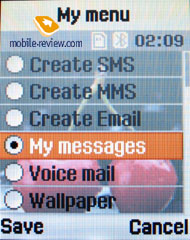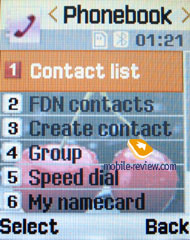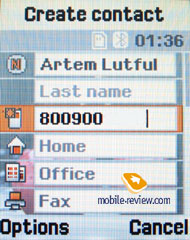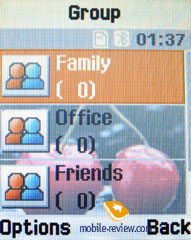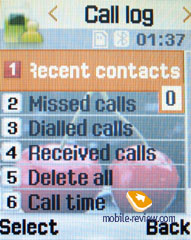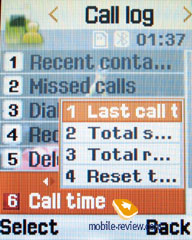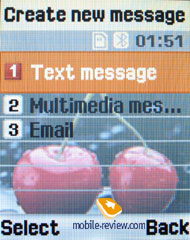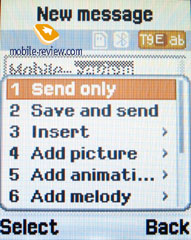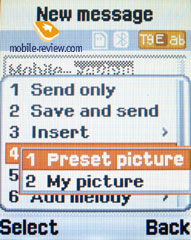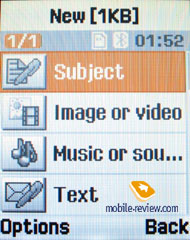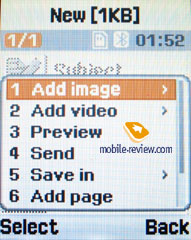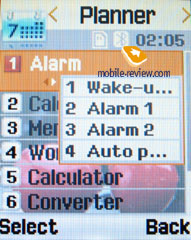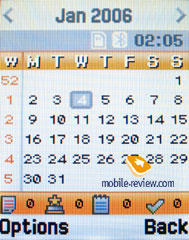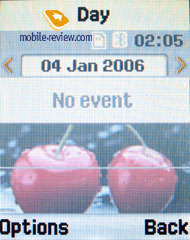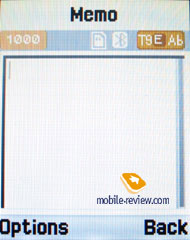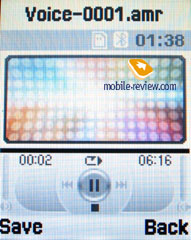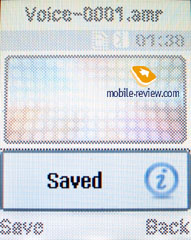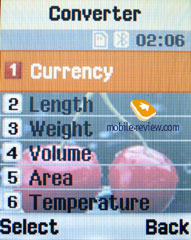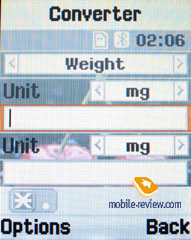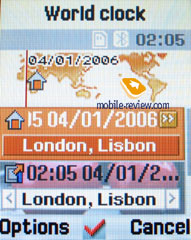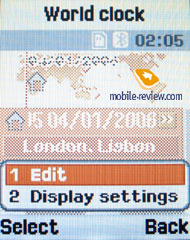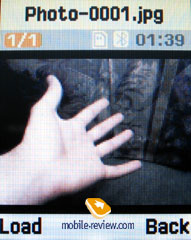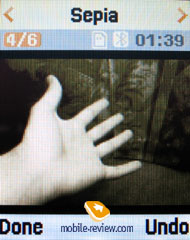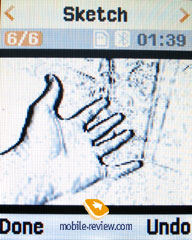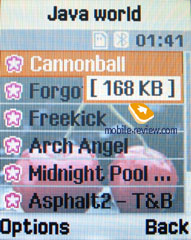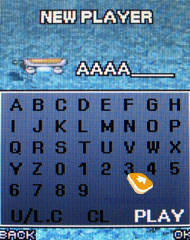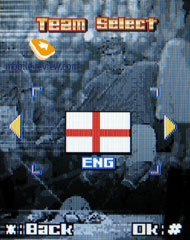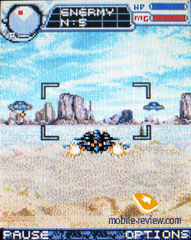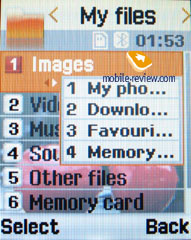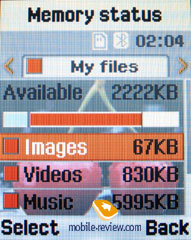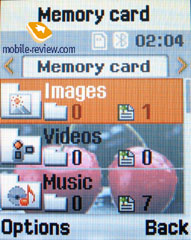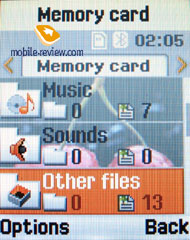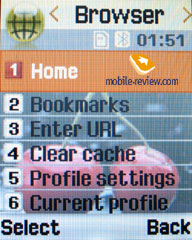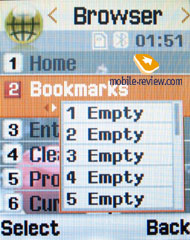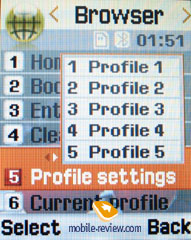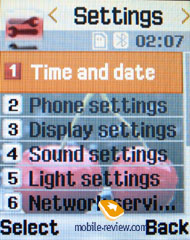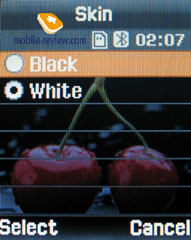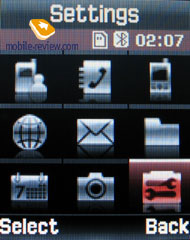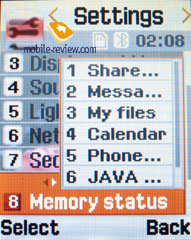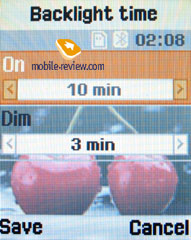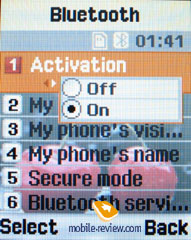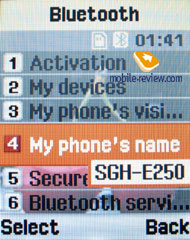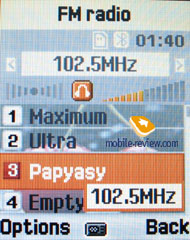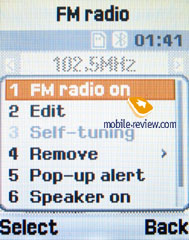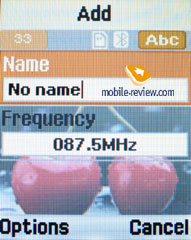|
|
Review of GSM-handset Samsung E250
Live photos of Samsung E250
Sales package:
- Handset
- 800 mAh battery
- User Guide
- Charger
- Stereo-headset
“City opens it mysteries… to those who can open them”
“Samsung is glad to offer a new range of sliders. We created three phones with different suites of features so as to allow everyone to choose a slider to his own liking”.
This is the prologue the official promo-site greets you with, which inaugurates a line of budget sliders: the X530, the E250 and the C300. It might sound surprising but the slogan above fully reveals the goal and the sense of these unsophisticated models release. Today we are taking a closer look at the second device in the range – Samsung E250.


Design and controls
The device sports a number of traits characterizing the senior offerings. For example, it can well be compared with the flagship of ultra-skinny sliders – Samsung D900. It is not about building particular design elements into the younger model - Samsung E250 is in fact an exact clone of the senior model, saving for a couple of difference in casing’s curves and the keys size. For an unsophisticated user it would be next to impossible to tell the difference between the two at a glance. All pros and cons of such approach have been discussed in our previous reviews so I won’t go over them again. I can only suggest you looking at the face-off of the two sliders. Samsung E250 is on the left and D900 is on the right.
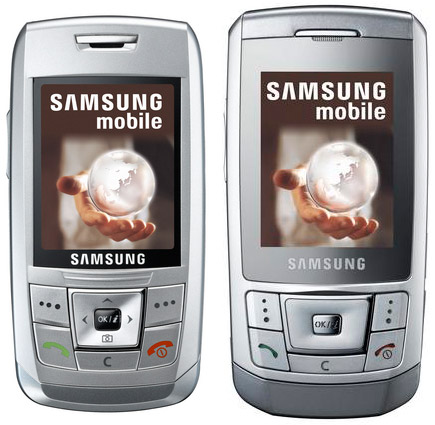
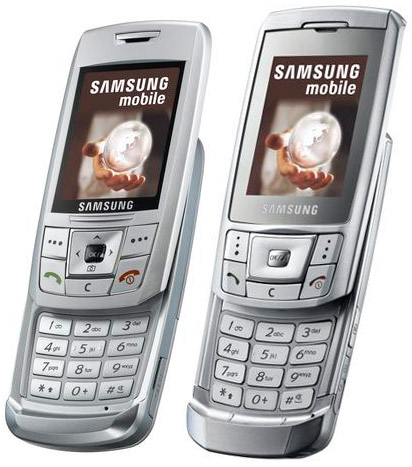

The handset comes in four color schemes: green, pink, black and silver. We got our hands on the handset of the latter trim. The E250, as we mentioned above, is designed after the D900. In terms of dimensions, the model is fairly compact (99x49.5x14 mm, weight 80 g). You will encounter no problem with carrying the handset in bag or trousers pocket or in a shirt. The model is not specifically targeted at male of female audience, it greatly depends on the color, and as for the rest, the handset will be fitting in both cases.



The E250 is made of standard plastic, which presents you with nothing special. On the front fascia, topping the screen, is the speaker combining the functions of earpiece and loudspeaker. To avoid fingerprints on the display when flicking the phone open, there is a special ridge right beneath it, which you can use as a thumbgrip. Further down is the navigation block with 2 soft keys, call receive/reject keys and traditional Samsung “C” key. In the centre is the five-way navigational key, which proved to be not very convenient for a number of reasons. Fist up, the key sits flush with the rest of the navigation block, then you don’t feel any key presses, there is just no adequate feedback. As a result you often have to press the same key several times to get a response. Wrong key-presses and taps on adjacent buttons are very typical for the E250. It is not possible to get used to the navigation button, for the problem with it is its design and poor placement.


Left spine plays host to volume rocker, a bit below is slot for memory expansion card. The device makes use of MicroSD type, the socket is covered with a flap made of soft plastic attached to the shell.

The right-hand side features only one socket for plugging in headset, data cable or charger. This slim slot is used on most of the company’s latest-and-greatest offerings. Much like the memory expansion slot, it is covered with a flap made of soft plastic.

Slid open, the E250 exposes VGA camera a self-portrait mirror on the back plate. Should you shut it, you’ll find out that the rear is free of any elements. The battery cover is with the help of 6 notches. Removing the cover is very simple; it will require no strain on your side, though the mounting is reliable and has no gaps. Under the cover is a 800 mAh Li-Ion battery. In the conditions of Moscow networks it lasted for about 3-4 days at 30 minutes of calls and up to two hours of radio usage a day.


The SIM-card holder is a standard slot in the middle part of the casing. The card is visible even with battery on place, but to take it out the battery should be detached first. To extract the card from the slot, just pull it out slightly.
The device is provided with spring-loaded slide mechanism, so that to zip the handset open just pull the top half up. The mechanism is moderately stiff, though we had no problems with opening the E250. The build quality is on a high level, the slider’s halves don’t produce any creaking noise, when opening the phone up, and there is no gap between them, be it in closed or open state.

With the phone flicked open, the area underneath the display houses numeric keypad. The keys come in slightly curved rectangular shape and are placed separately from each other what brings down the possibility of wrong key presses. Generally speaking, the keypad, key bar is quite comfortable to use, but the issue of insufficient feedback doesn’t bypass this part either – keys present you with very short travel. The buttons are evenly lit in light-blue. Mediocre brightness of the backlighting makes it even handier in use – in poor light conditions it doesn’t make your eyes strain.


Display
The TFT-display at 128x160 pixels (32x40 mm) found in the E250 shows up to 65000 colors. The viewing angles can not boast superb values, as even on slightest deviations the picture gets considerably distorted. In the sun this display does no good, the picture fades but the information remains legible. The screen y is rather competent for an entry-level device – it doesn’t have any outstanding specs or quality, but is quite fitting for daily use.
Menu
The main menu features 9 items and traditionally can be displayed either in the grid mode (3x3) or in the list form. If the latter is the case, then once you’ve selected the needed item, the right part of the screen gets filled up with “sub-menu” – a scaled-down list of the section’s contents. Moving into it is possible by pressing the navigational key rightwards, and to view it full-screen, just press OK.
Another handy addition to the menu layout – the handset memorizes which function was called up last time and when you re-enter the menu the phone automatically highlights it, this goes for sub-menu items as well.
Apart from the navigation keys you can turn your sight to shortcut number navigation for browsing through the menu – each menu item has its own number on the list. At that three directions of the navigational key are very user-manageable, the only exception is Up, permanently assigned to My Menu, but in return you are free to customize any of the five items found in My Menu.
Phonebook. The phonebook in the E250 can store up to 1000 entries, each with a variety of fields and phone numbers to fill: First Name, Last Name, Mobile phone, Work phone, Home phone, Fax, extra number and e-mail. Every contact can be personalized with an image of a ring tone, as well as added to a group or enhanced with a text note. By the way, custom tunes may be set for groups as well, however if a contact with a personal ring tone, is in a group, the on an incoming call the latter tune gets higher priority.
The phonebook features entries from both the handset’s and the SIM-card’s memory.
When submitting data for a contact on SIM-card, the selection of available fields is much less impressive: Name, Phone number and ID. There are also options for binding up a contact with a custom ring tone, image and group, yet on an attempt to do so the handset notifies you of these features being enabled only for data stored in the handset’s memory and suggests moving the entry over there.
For improved experience of trading your contacts back and forth, the handset allows a namecard with six phone numbers, e-mail and a text note – after filling in all the fields you need, this card can be sent as SMS, MMS or via Bluetooth to other devices.
Speed dial feature with up to 8 numbers on the list is also onboard, at that different keys may have specific phone numbers of one contact.
Call log. Each of the lists displays up to 30 phone numbers, there is also a merged list available, where next to each contact name (or phone number) is a call type icon (on the left) and number of calls made (on the right). To switch between the lists (Missed Calls, Incoming, Outgoing) you can make use of the navigation key. Detailed view for each entry reveals date and time of call, caller’s name, if available in the phonebook, otherwise a phone number, however call duration is not recorded here.
Messages. The messaging department of the E390 is quite standard – when attempting to create a new message you are offered three types to pick from: SMS, MMS or e-mail – with each having its own suite of settings. Text messages may have pictures, animations, tunes, namecard from the phonebook or other kind of data taken from the organizer (reminder, memo or task) attached.
The interface layout for MMS is straightforward and easy to master: you can add a text message, tune, image or a video clip, however all this shouldn’t exceed 295 Kb in size. The E250 comes pre-installed with several message templates as well.
As for e-mail settings, there are no difficulties at all. You should only specify address, server settings (POP3 and IMAP are supported) and the type of massages upload (full or headers only). Having done all these things you will fully enjoy working with e-mail in your handset. The only restriction is a size of incoming massage. You may download from server to the phone only 100 Kb.
To store SMS-messages, 200 slots are available in the phone memory, for MMS- and E-mail messages the E250 makes use of free memory left.
Also there is a useful function for sending SOS-messages – when activated, should you find yourself in an emergency, after pressing the volume key four times, the message «I am in emergency. Please help me» will be sent to contacts submitted earlier, all incoming calls from these numbers upon sending the emergency message will be picked up automatically. Recipients (not more than 5), as well as number of Repeats may be set up manually, while text of the SOS-message is not manageable.
Organizer. The phone’s memory is good for storing up to 100 events of each of four types: appointment, anniversary, task, others. For every entry you set start and due dates and times, and location. You are also at liberty to turn on a reminder, adjust the time when it should trigger off and make it repeated (if needed). In tasks you are offered to enter the contents of a task, start and due dates and times, as well as priority (low, normal, high). Calendar may be viewed in month or week mode.
Memos on the E250 are dead-simple, presenting you only with text message and date fields. The phone memory is good for storing up to 100 memos.
Opening Alarm Clock section you will find three alarms in there: Morning Alarm, Alarm1 and Alarm2. However they are no different in terms of functionality: you set up time, repeat mode and alert tune.
The bundled calculator can perform not only the very basic operations but calculate logarithms, roots, sin, cos and other functions like these ones. The way it is implemented is quite nice – it allows for submitting a whole formula with several operations and brackets and only then gives you the result.
Unit converter, as well as countdown timer and stopwatch (saves up to 4 intermediate results) is onboard.
The unsophisticated Voice Recorder allows making .amr voice clips for sending via MMS and Email which are capped at 1 hour. This feature doesn’t work during calls.
World clock. Time is shown for all time zones, on top of that for each zone you will get a list of its three biggest cities. For standby mode you can pick up to two time zones with time, date, date format and week-start day. If you wish, you can save entries for three time zones, but that list will be available only within the application.
MP3-player. The bundled player supports .mp3 and .aac formats and is incapable of working in background mode, thus after launching the application all you have got left to do is close the slider and enjoy your favorite tunes. Standard playback modes are enabled on the E250 – sequential, random playback and shuffle. You are at liberty to create playlists and group the tracks inside them in the way you wish (tracks order can be changed manually). Both equalizer and presets are missing on the handset, but in return it empowers with an ability to send tracks over Bluetooth onto other devices and set them as ring tones.
ImageEditor is a simplest application for editing phots. With the help of it you are free to apply various effects, as well as add frames and objects to an image.
JavaWorld. The E250 comes included with quite a number of preinstalled games: Cannonball, Forgotten Warrior, Freekick and Arch Angel. Much like other Samsung-branded devices, uploading Java via Bluetooth or a data cable in default mode is not supported – to do that you will have to look up in service settings and turn on a corresponding option on, but even with that done, data transfer stability leaves much to be desired. A more common way of loading apps you may use Internet (WAP-GPRS). There is 4 Mb of memory reserved for Java applications.
File Manager. This application categorizes all files by types: music, pictures, video, sounds and other. For storage purposes the E250 possesses 10 Mb of built-in memory and don’t forget to add a memory card to this as well. Only list-type layout is enabled.
Browser. The default Browser has nothing to shout about. It allows surfing both WAP and ordinary HTML-pages, however a page should not be bigger than 500 Kb. Since full size pages are too large for the phone screen you will have to use scroll bars to browse them.
Camera. The camera Samsung E250 carries onboard can be attributed to the initial generation. The handset packs a VGA-camera with 640x480 pixel image resolution. Frankly speaking, camera is quite poor but rather successfully copes with its main task – making photos for contacts. But don’t expect something on top of that. Such settings as shooting mode, snap resolution, quality, exposition settings, white balance and photosensitivity can be customized. Besides that you are free to apply one of the overlays.
 |
 |
(+)
maximize, 640x480, JPEG |
(+)
maximize, 640x480, JPEG |
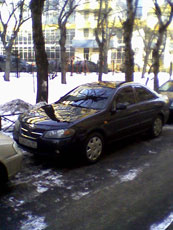 |
 |
(+)
maximize, 640x480, JPEG |
(+)
maximize, 640x480, JPEG |
 |
 |
(+)
maximize, 640x480, JPEG |
(+)
maximize, 640x480, JPEG |
 |
 |
(+)
maximize, 640x480, JPEG |
(+)
maximize, 640x480, JPEG |
 |
 |
(+)
maximize, 640x480, JPEG |
(+)
maximize, 640x480, JPEG |
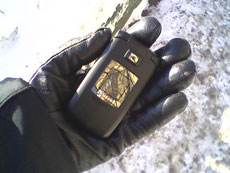 |
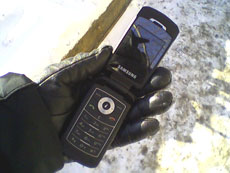 |
(+)
maximize, 640x480, JPEG |
(+)
maximize, 640x480, JPEG |
Video is recorded in .3gp format with the top resolution making up 176x144 pixels, overlays here are no different from what you will find in still images settings.
Settings. The Phone settings are pretty standard, so I won’t specifically bring them into the limelight. The Display settings allow you to set up wallpaper, main menu view (list or grid), skin (black or white) and brightness.
The Sound settings are nothing special on the E250 as well – ring tone, volume, sound notification for inbound messages and key tone – this is what Sound section is limited to. Any tune you like can be set as a ring tone, whereas incoming messages is where Samsung got a bit greedy – you are restricted to select any sound but one of the default list. Profiles system is missing on the E250, thus at meetings or other ringing-phone-unfriendly events you will have to stick to the silent mode.
Bluetooth settings are nothing new – the handset supports A2DP profile for transferring stereo-sound to a headset wirelessly.
FM-radio. The phone memory can store up to 30 radio-stations, enabling you to assign the name to each of them. Radio works only with the headset plugged in which is used as an antenna. Apart from the earphones you can enjoy music via the phone’s speaker (the headset, of course, should be plugged in). Radio is incapable of working in background mode.
Impressions
In terms of reception quality, when tested, the E250 delivered no problems, everything worked quite well. The volume of 64-chord polyphony is enough for most cases, besides you always can set an MP3 track as a ring tone. During talk person on the other end clearly hears what you say without any distractions, so do you. As for the silent alert, it is of average strength-wise, so having put the slider into the pocket of outerwear you may well miss a the call.
The way Samsung positions this offering was revealed at the beginning of our review. We can only add that in terms of the build quality, the E250 lives up to the bar set by other Samsung-branded solutions. As regards software, as you could notice, it is quite similar to that found on most modern devices by this manufacturer.
The E250 is expected to be available for purchase at the price of 190-200 USD early in March 2007. The price is quite adequate, the model is not remarkable for any specific features but in the sense of design the E250 is a copycat of Samsung D900. FM-radio and slot for memory cards are two welcome additions, for those who will tip towards the device for it slimness and similarity with more expensive Samsung D900.
Artem Lutfullin ([email protected])
Translated by Vera Paderina ([email protected])
Published — 28 March 2007
Have something to add?! Write us... [email protected]
|
News:
[ 31-07 16:21 ]Sir Jony Ive: Apple Isn't In It For The Money
[ 31-07 13:34 ]Video: Nokia Designer Interviews
[ 31-07 13:10 ]RIM To Layoff 3,000 More Employees
[ 30-07 20:59 ]Video: iPhone 5 Housing Shown Off
[ 30-07 19:12 ]Android Fortunes Decline In U.S.
[ 25-07 16:18 ]Why Apple Is Suing Samsung?
[ 25-07 15:53 ]A Few Choice Quotes About Apple ... By Samsung
[ 23-07 20:25 ]Russian iOS Hacker Calls It A Day
[ 23-07 17:40 ]Video: It's Still Not Out, But Galaxy Note 10.1 Gets An Ad
[ 19-07 19:10 ]Another Loss For Nokia: $1 Billion Down In Q2
[ 19-07 17:22 ]British Judge Orders Apple To Run Ads Saying Samsung Did Not Copy Them
[ 19-07 16:57 ]iPhone 5 To Feature Nano-SIM Cards
[ 18-07 14:20 ]What The iPad Could Have Looked Like ...
[ 18-07 13:25 ]App Store Hack Is Still Going Strong Despite Apple's Best Efforts
[ 13-07 12:34 ]Infographic: The (Hypothetical) Sale Of RIM
[ 13-07 11:10 ]Video: iPhone Hacker Makes In-App Purchases Free
[ 12-07 19:50 ]iPhone 5 Images Leak Again
[ 12-07 17:51 ]Android Takes 50%+ Of U.S. And Europe
[ 11-07 16:02 ]Apple Involved In 60% Of Patent Suits
[ 11-07 13:14 ]Video: Kindle Fire Gets A Jelly Bean
Subscribe
|

